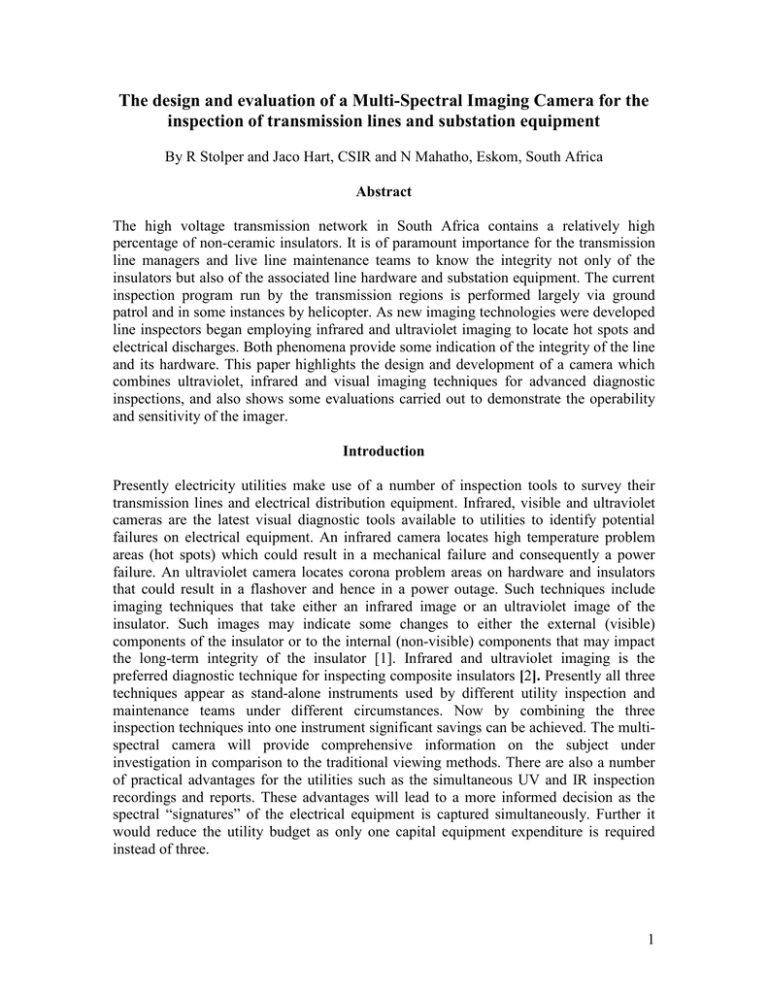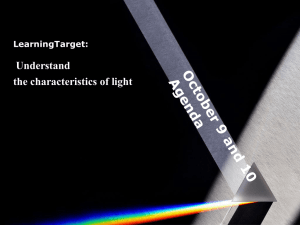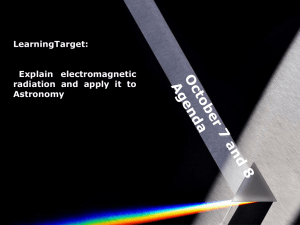The design and evaluation of a Multi
advertisement

The design and evaluation of a Multi-Spectral Imaging Camera for the inspection of transmission lines and substation equipment By R Stolper and Jaco Hart, CSIR and N Mahatho, Eskom, South Africa Abstract The high voltage transmission network in South Africa contains a relatively high percentage of non-ceramic insulators. It is of paramount importance for the transmission line managers and live line maintenance teams to know the integrity not only of the insulators but also of the associated line hardware and substation equipment. The current inspection program run by the transmission regions is performed largely via ground patrol and in some instances by helicopter. As new imaging technologies were developed line inspectors began employing infrared and ultraviolet imaging to locate hot spots and electrical discharges. Both phenomena provide some indication of the integrity of the line and its hardware. This paper highlights the design and development of a camera which combines ultraviolet, infrared and visual imaging techniques for advanced diagnostic inspections, and also shows some evaluations carried out to demonstrate the operability and sensitivity of the imager. Introduction Presently electricity utilities make use of a number of inspection tools to survey their transmission lines and electrical distribution equipment. Infrared, visible and ultraviolet cameras are the latest visual diagnostic tools available to utilities to identify potential failures on electrical equipment. An infrared camera locates high temperature problem areas (hot spots) which could result in a mechanical failure and consequently a power failure. An ultraviolet camera locates corona problem areas on hardware and insulators that could result in a flashover and hence in a power outage. Such techniques include imaging techniques that take either an infrared image or an ultraviolet image of the insulator. Such images may indicate some changes to either the external (visible) components of the insulator or to the internal (non-visible) components that may impact the long-term integrity of the insulator [1]. Infrared and ultraviolet imaging is the preferred diagnostic technique for inspecting composite insulators [2]. Presently all three techniques appear as stand-alone instruments used by different utility inspection and maintenance teams under different circumstances. Now by combining the three inspection techniques into one instrument significant savings can be achieved. The multispectral camera will provide comprehensive information on the subject under investigation in comparison to the traditional viewing methods. There are also a number of practical advantages for the utilities such as the simultaneous UV and IR inspection recordings and reports. These advantages will lead to a more informed decision as the spectral “signatures” of the electrical equipment is captured simultaneously. Further it would reduce the utility budget as only one capital equipment expenditure is required instead of three. 1 The CSIR and Eskom were the first to present a ISH paper in 1997 on the development of a “Day light corona discharge observation and recordings system” [3]. Since then the CSIR and Eskom have collaborated closely in the development of new diagnostic tools specifically for application to transmission line inspections. As a result of this partnership a range of corona detection cameras evolved which have been used by various utilities worldwide. The hot spots and corona discharges seen from electro-magnetic perspective The wavelengths of the electromagnetic spectrum are divided into different categories, named after its application, such as the x-ray domain for short wavelengths with powerful penetrable photons, the visible spectrum where human beings can observe objects and the long length radio waves where communication waves are transmitted and received. The multi-spectral imager explores the ultraviolet wavelengths between 200nm to 280nm, the visible wavelengths of 400nm (dark blue) to 780nm (red) and the heat wave lengths of 8µm to 12µm, as illustrated in figure 1. Figure1: Electromagnetic spectrum used in multi-spectral imager Corona activities on electrical equipment radiate energy in the form of light, mainly in the ultraviolet band of the electromagnetic spectrum 300-400nm [4] (spectral peaks at 340 and 360nm). However, a small portion of the corona energy radiates below 280nm in the so called solar blind spectrum. In this part of the electro-magnetic spectrum, below 280nm and onwards, no solar radiation reaches the earth surface due to the ozone layer around the earth sphere which acts as filter and blocks all ultraviolet C and soft x rays. Under normal conditions objects are seen due to reflected light that is projected on a sensor. But in case of the solar blind spectrum only active radiation sources are seen, no reflection patterns such as contours are seen. The irradiance characteristics of corona are shown in Figure 2. 2 Figure 2: Spectral irradiances of corona A current flowing through a high resistance caused by a poor electrical contact between two surfaces results in an electrical I 2 R loss appearing in the form of heat. The temperature range for a hot connection varies according to the load and resistance and may be anywhere between 10˚C above the ambient temperature to approximately 100˚C and above. The greater the load on the network, the greater is the I 2 R effect which can eventually lead to burnt connections and damage, and even possibly power outages. It is therefore important to scan the electrical network on a regular basis for hot spots. Electrical hot spots radiate energy in the so called long wavelength infrared spectrum, depicted as LWIR in Figure 1. The Development process The CSIR has developed in collaboration with Eskom a multi-spectral imager as part of the research programme, initiated in 2003. The objective was to develop an instrument that combined all three imaging technologies, thus making for a more practical instrument while at the same time being user-friendly for field personnel. The approach was to develop an instrument that fulfils the need of the line workers on the ground. A number of interviews were conducted with Eskom’s regional transmission managers and line workers in order to determine the user requirements and from there to deduce the instrument specifications. The critical user requirements are given in Table 1: 3 Ergonomics Modern, compact and convenient to handle Size Small and portable Weight Less than 4 kg, including battery NETD, indication of IR performance 0.5˚ C UVc, Corona sensitivity Small discharges Supply Battery off the shelf, re-chargeable Li-Ion Environment factors IP66, International standard splash proof Operation menu Simple and easy to operate with on screen menu Field of view Reasonably small but not too small, typical 1cm detail on 4 meter length insulator at 25 m distance, with zoom capability Recording facility On board video and audio recording preferred Table 1: Basic User requirements The individual building blocks and system The camera consists of three different detectors with each having its own unique set of filters and lenses. As the ultraviolet image reveals only the active sources of corona, this had to be projected onto the visual image in order to determine it’s geometrical location. This overlay is achieved by aligning the optical axes of the ultraviolet and visible channels to one optical centre line by means of two dichroic mirrors, each at 45 degrees to its respective detector, as shown in Figure 3. The two fields of views are identical. Although a similar optical alignment concept was considered for the IR channel it hasn’t been executed for reasons of performance and manufacturing cost. It is also not required for the image recognition as the IR image radiates sufficient energy to form a recognisable scene. However, it is possible for scene recordings at infinity distance to overlay the corona discharge image onto the infrared image. IR Channel Day Light Channel UVc Channel Figure 3: The principle optical layout 4 The aim of the optical design was to have maximum energy throughput with the minimum of optical components in terms of mirrors, filters and lenses. The incident energy on the sensors is directly proportional to the aperture size of the first window. The design is based on a 100mm focal length lens with an effective 10 degree field of view. The IR detector The infrared aperture The visual detector The UVc detector The visual and UV aperture The ultraviolet channel The first UV mirror, adjustable The second UV mirror Figure 4: The opto-mechanical lay-out of the three channels The ultraviolet channel The purpose of the ultraviolet channel is to detect and locate the discharge source on the electrical equipment. Discharges are formed due to a number of factors such as: problematic insulators, problems pertaining to hardware and wear and tear on equipment. Corona radiates energy in the form of light and sound. This light, existing of photons (energy pockets), is projected onto an image intensifier tube by means of lenses and filters. The quantum energy of the released photon incident on a detector is calculated by [5]: Ε = hv = hc λ (J / photon ) h = Planck ' s cons tan t = 6.6252 × 10 −34 J s c = speed of light = 3.0 × 108 (m / s ) λ = wavelength(m ) For a photon at 265 nm the energy is E = 7.50 × 10 −19 J, while the energy for a green photon at 500nm is 3.97 × 10 −19 J and for an infrared photon at 10µm wavelength 5 is 1.98 × 10 −20 J . It is evident from this calculation that the short wavelength photon holds more energy than the long wavelength photon. Therefore the detector material for converting the photon energy to a photon-electron signal has to be of different type of material. Most electro-optical detectors can be classified as one of two major types: quantum detectors (photo-detectors) or thermal detectors. Quantum detectors absorb quantities of optical radiation energy resulting in a change in energy state of electrons in the detector material while the thermal detector responds to absorbed optical radiation with increased thermal (vibrational) energy within the detector material [6]. For detecting the corona a ultra-violet quantum detector is used in the form of an image intensifier tube with a Cesium-Telluride photocathode. The Cs-Te photocathode converts the detected photons into photo-electrons at a conversion rate of 18% after which a double stage micro channel plate amplifies the weak signal 2 million times. The photoelectrons are read out by a standard CCD detector and processed by the electronic circuit. The infrared channel The infrared channel of the camera converts the detected thermal image into a visible image which is displayed on the monitor. The infrared spectrum is classified into three different spectra with their associated detector types and detectable temperatures, as shown in Table 3.6 [7] Emission from a 290K blackbody W / m2 Ground level solar radiation W / m2 0.78-1 3-6 4.1 24 6-15 127 1.5 Spectrum Wavelength range (µm) Near infrared (NIR) Medium wavelength IR (MWIR Long wavelength IR (LWIR) Table 3: Spectra with their detector types and detectable emissions In general, the 8-15µm band is preferred in the inspection industry for its high thermal performance because of its higher sensitivity to ambient temperature objects (a factor of 30 times), its immunity to reflected sunlight (a factor of 16 times) and its better transmission through mist and smoke [8]. This is particularly true for the inspection of electrical transmission equipment where it is expected that the maximum object temperature would not exceed 200˚C. For this reason it was decided to use the latest available uncooled microbolometer detector technology. A bolometer is a temperature-sensitive electrical resistor. Its operation is based on its temperature rise caused by absorption of incident radiant energy. The change in temperature causes a change in electrical resistance, which is measured by 6 electrical circuitry [9]. Traditional infrared detector manufacturers cooled the detectors to temperatures as low as 70K in order to improve the minimum resolvable temperature difference performance. Uncooled infrared detectors are now freely available for various applications. Their simple operating conditions are similar to those of CMOS Active Pixel Sensor (APS) or CCD digital camera. The latest micro bolometer detector is used with a pixel configuration of 320x240, 35µm pitch and 80mK NEDT. NETD (Noise Equivalent Temperature Difference) indicates the temperature resolvable power of the camera, for this detector a minimum of 80mK scene temperature difference can be resolved. The visual channel A colour camera based on a charged couple detector with extraordinary zoom capabilities was chosen for visualising the object under investigation. This colour image is the reference picture for the operator in terms of excessive temperature increase or discharge activity. The UV image is overlaid onto the visible image so that the operator sees where the discharges are positioned. Electronic signal and imaging processing Figure 5: The electronic signal processor The following electronic signal processing occurs: This multi-spectral imager instrument is a complex instrument in terms of the nature and the number of the different electronic signals to be processed: three different formats of 7 detector signals are received, a large number of data and control signals have to be processed simultaneously and the individual data signals have a high bandwidth. Therefore the digital video mixer employs a FPGA (Field Programmable Gate Area) device for controlling and processing all the electronic signals. The current FPGA contains 32k logic elements, 3.3M Bits on board RAM and 12 DSP blocks. Input: Three different spectral imaging detectors with associated decoders for converting the analog signal into a digital signal for signal processing and image manipulation. Output: One S-VHS video signal for the display of a colour image in the LCD eye piece and for recording purposes. Accessory signal processing capabilities: GPS, audio recordings and still video image recording. Evaluation of the Multi-Spectral Imager In order to evaluate the sensitivity of the multi-spectral imager a number of tests were conducted at the University of Kwazulu Natal, Durban. Various substations were also scanned for discharges activities and hot spots. The test conditions for the Natal tests are listed in Table 4. Test and Environmental factors Insulator type and background Four tests conducted Temperature Humidity Altitude Sunshine Distance Measured values Composite rubber, length 4.2m, 67 sheds, 7 years in service at a 400kV substation, removed from service due to unusual discharge activity along the length of the insulator 120kV and 160kV, both dry and wet Approximately 17˚C High, precipitation for the second part of the test 50 meters above sea level No sunshine, heavily overcast Approximately 8 meters from the test specimen Table 4: Testing conditions It was important that the evaluation be carried out under natural daylight conditions rather than in an indoor laboratory environment where the UV content produced by fluorescent and other lighting is expected to be well below natural daylight levels. [11] The experiment was conducted on the roof of the High Voltage Laboratory at the University of Kwa Zulu Natal, Howard College Campus where the insulator could be subjected to periods of high voltage stressing in an outdoor environment under both dry and wet conditions. The test arrangement is shown in Figure 6, and the insulator under test had visible damage along the sheath as shown in Figure 7. The insulator is rated at 400kV but for this work, there were two voltages applied to the insulator, namely, 120kV 8 and 160 kV under both dry and wet conditions. Activity at the damaged portion of the insulator was observed, in both the ultra-violet and infra-red spectrums, at these low voltages (approximately half the rated voltage) and hence provided some verification of the sensitivity of the multi-spectral imager. The images below are arranged in sequence of dry and wet conditions. Multi-Spectral Imager CoroCAM IV+ daylight corona camera Figure 6 The Kwazulu Natal University test set up, on the left the Multi-spectral Imager, on the right the CoroCAM IV+ corona camera and in the background the suspended non ceramic insulator. Figure 7: The visible damage of punctures along the sheath of the test insulator 9 Figure 8: Ultraviolet, Infrared greyscale & iron bow images from the Multi-Spectral Imager under dry conditions at 20kV Figure 9: Ultraviolet, Infrared greyscale and UV overlaid on IR images under wet conditions at 120kV, note the increase in corona activities Figure 10: UV, IR iron bow and UV overlaid IR images under dry conditions at 160kV, note the increase in length of the hot spot Figure 11: UV, IR iron bow and UV overlaid IR images under wet conditions at 160kV, note the IR blurring 10 From the outdoor laboratory evaluation we see that the Multi-Spectral Imager provides very good information relating to the existence and location of the corona and heat sources along the length of the insulator. We also see good correlation between the images in term of exact location as related to the actual damage. We note that the discharge activity increases when the insulator is wet, and also with the increase in voltage which can be expected. A 400/275kV substation was scanned in order to test the camera performance and the following recordings were obtained. Figure 12: Infrared and overlaid UV image of a line spacer with discharge activities on its edges Figure 13: Infrared and overlaid UV image (cold colour palette) of 11 transformer bushing with corona activity on the conductor clamp Figure 14: Infrared picture of transformer bushing, note: the top conductor clamp is slightly hotter than the cap The recordings in figures 14 to 16 prove that it is beneficial to scan substation equipment simultaneously with an infrared and ultraviolet imager as the UV- Visible-IR combination provides the user with the complete equipment performance picture. Furthermore, it is an advantage to have UV and IR images recorded in the same climatic conditions, at the same time and from the same point of observation as this will lead to a more reliable interpretation of the recordings. Conclusion and future activities The establishment of the multi-spectral imaging technology with its ability to detect and to locate problematic areas has been achieved and now the next phase is to quantify what is seen. The next phase therefore will be to concentrate on the quantification of the corona in electrical and radiometric terms and to quantify the thermographic infrared information received. Already at this stage of the development there is huge potential for the application of the imager in the transmission inspection environment. The practicality of having one instrument possessing three imaging technologies would mean considerable cost savings, and improved line and substation inspections. References [1] [2] [3] FF Bologna, “Infrared and ultraviolet imaging techniques applied to the inspection of outdoor transmission voltage insulators”. CIGRE Study Committee 22, “Insulators – review of in-service diagnostic testing of composite insulators”. WL Vosloo, R Stolper, “Daylight corona discharge observation and recording system”, ISH, 1997. 12 [4] [5] [6] [7] [8] [9] [10] [11] F Grum, LF Costa, “Spectral emission of corona discharges”, Applied Optics 15, 1976. Lewis J Pinson, 1985, p3 Dito p6 A Rogalski, “Infrared devices and techniques”, Opto-electron, Rev 2, 2002. Dito Paul W Kruse, Uncooled Thermal Imaging, SPIE Publication TT51 Bruno Fieque, 320x240 uncooled microbolometer 2D array for radiometric and process control applications, SPIE 5251 2003 DA Hoch, N Mahatho, FF Bologna, “Evaluation of in-service diagnostic tools”, Eskom internal report, RES/RR/02/18817. Meet the Authors Roel Stolper Roel holds a Bachelor Technology Degree in Electronic Engineering from Tshwane University of Technology, Pretoria, South Africa. He is currently a Technical Specialist in Electro-Optical engineering at CSIR. He has for some time been the Project Manager on development and commercialisation of HV system fault detection and imaging products, including the CoroCAM corona detection range. He is currently the CSIR Project Manager for developing diagnostic inspection equipment on behalf of Eskom SA. He is member of the SA Institute of Electrical Engineers and of the optical society SPIE America. 13 Jaco Hart Jaco was trained as precision mechanics instrument maker at the CSIR and obtained a National N6 diploma. He honed his skills in opto-mechanical design, led and was involved in a number of optical system projects that includes long distance surveillance, synchro ballistic and high speed camera design, various infra red systems packaging and the Corcam504 and Multi-Spectral projects. Nishal Mahatho Nishal holds a National Diploma in Power Engineering, a Diploma in Project Management and is a member of the South African Institute of Electrical Engineers (SAIEE). He is currently employed by Eskom Resources and Strategy and his present research interests include transmission insulator research, hvdc live line requirements, lightning performance of sub-transmission lines, transmission line performance and is also currently managing a reference book on Electromagnetic Compatibility for Power Utilities. 14




